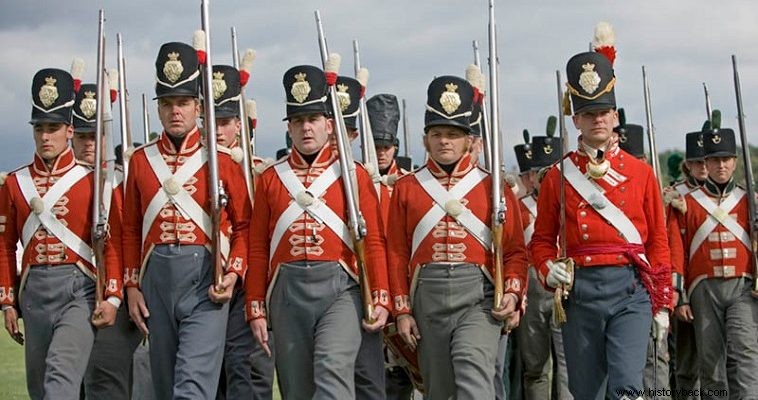
Until recently scholars of military history have argued that the key to British infantry's success against their French counterparts was their firepower, a consequence of their formation in a two-pronged line versus the French three-pronged lines or phalanxes attack depth of six, nine or even 12 yoke.
This view is only partially correct. In contrast the British relied, in fact, on the "queen of battle" bayonet much more than the aggressive French. The spear charge is nothing new on the battlefield. As early as the 1680s, the French infantry equipped with "planter" bayonets charged without using fire against their opponent.
During the Great Northern War the Swedes of Charles XII they followed a similar tactic, but combining the bayonet attack with volleys of fire, at close range from the enemy, moments before the final assault.
The martial art theorists de Follard and de Saxe who fought and wrote in the 18th century also favored the offensive tactic, with the attack being prepared by fire. Frederick the Great also applied this tactic during the First and Second Silesian Wars (1740-42, 1745). However, he later revised and taking advantage of the excellent discipline and high level of training of his men relied on the firepower of his infantry, which became capable of firing up to seven rounds per minute.
However, the British, taking advantage of their own national characteristics, i.e. composure and determination, managed to make their soldiers, who were largely the dregs of their society, among the best of the time.
The British tactic was simple in conception and proved absolutely effective in practice. The infantry was trained to hold their fire until the moment when he would be ordered to shoot, at a distance of 30, 20 or even 15 m. against the approaching enemy.
The British infantrymen lowered their muskets, "aiming" at the opponents at belly level, so that they were sure to hit him despite the strong recoil of the musket, while in their ranks there was absolute silence so that the orders of the officers could be clearly heard . After one or at the most two volleys from these distances, which were absolutely devastating, the British, by order, raised their muskets and charged with the bayonet against the confused enemy.
The opponents, shocked by the sight of their colleagues being cut to pieces by the British fire, were unlikely to withstand the psychological shock of an attack by a "forest" of bayonets only a few meters away from their bodies. So in the vast majority of cases the French "broke" their yokes and put it on their feet.
"They were coming at us slowly and silently at first. But when they reached a distance of 100 m. they let out a strong yach and rushed forward. The behavior of the French is in stark contrast to the composure of the British. Our men were waiting for the French without any of them leaving the lines and waiting for the order to fire", says a British officer in his diary.
"We set a line against them and charged with three ships. All was death. They came upon us with shouts and shouts reaching up to the points of our bayonets. They could not withstand our silence and our decisive attack. They put it to the feet without much resistance," says an anonymous Dark soldier.
The composure of the British infantry that appeared in every battle impressed enemies and allies alike. The absolute order and quietness with which they received the enemy attack and so alienated the French, apart from the British temperament, was also the product of the excellent training and control exercised by officers and non-commissioned officers over their soldiers.
Many sources report that after the first yach all that could be heard was the calm voice of officers and non-commissioned officers saying, "Steady boys, steady." "We could hear our colonel telling us calmly but decisively, calm guys, no rush," reports a soldier.
"In my first battle, I felt my mind disappear and my breath cut off. The silence that prevailed in our lines was absolute. Then I looked at our lineup. That sight alone was enough to cheer me up. The calmness and stability of my companions filled my heart with strength and armed me with determination. How different and noisy was the advance of the French!", reports an anonymous Dark soldier.
Perhaps the best description of British tactics, however, comes from a Frenchman, Colonel Bouzot, who faced the thin red line.
"Our men were excited. One encouraged the other and all together moved with greater determination. Our phalanx fell into slight confusion in the advance The English remained silent, motionless with their guns at present. From a distance they looked like a long red wall. Soon we approached them shouting:Forward! Long live the emperor! Through the spear.
“Some of our men raised their rations on their bayonets. Our advance developed into a street fight, with disorder prevailing and some men fighting. The English line stood still and silent, with muskets always at present, even when we were within about 300 meters and our storm attack would hit them in minutes.
“The contrast was great. Soon, seeing the English not firing, holding back their fire, we understood that when we received them the situation would not be pleasant at all. Our psychology was turned upside down. The idea had now taken root in our minds that we could not counter the moral advantage of their incredible unrest.
"During this painful wait we saw the English raise their muskets and aim. The feeling of the coming firestorm froze many of our men. Many started shooting individually and aimlessly. Suddenly their steady, concentrated volleys decimated our lines. We retreated trying to regain our order and courage. Then three consecutive yaches broke the silence and at the sight of their sabers we ran in disorderly flight"...
